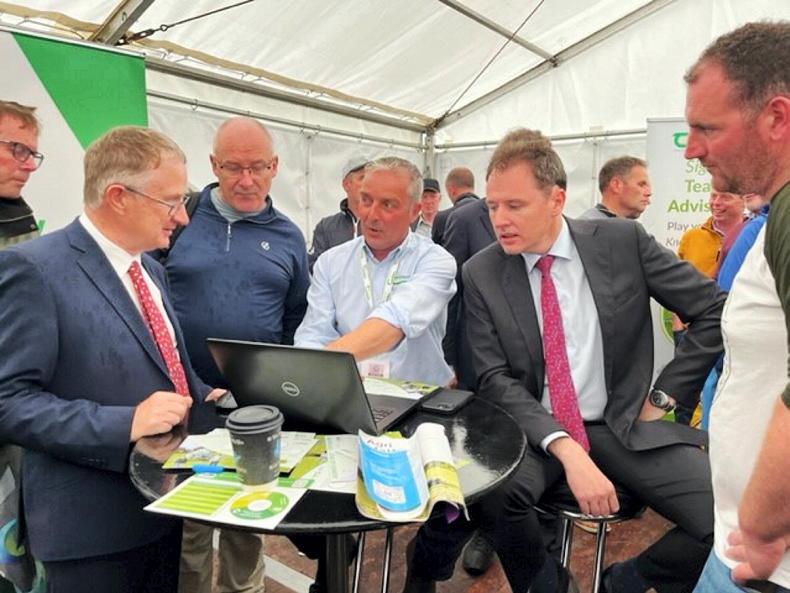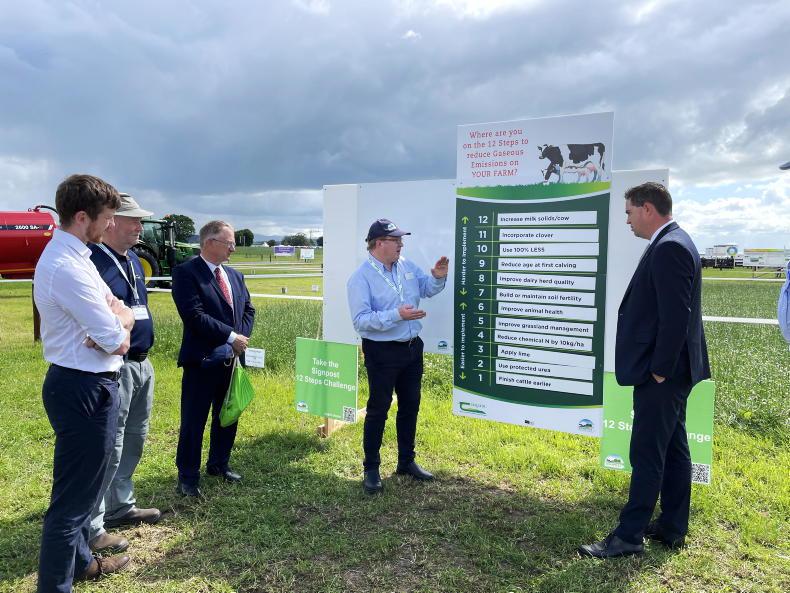Teagasc launched the new Marginal Abatement Cost Curve (MACC) this year, highlighting the key areas that we need to focus on in reducing greenhouse gas emissions.
The top five actions in the new MACC include reducing our reliance on chemical nitrogen (N), a switch in fertiliser type to protected urea, reducing age at slaughter, the use of feed additives and diversification.
Others include dairy herd EBI, slurry aeration and additive options, reducing crude protein content in animal feed, extending grazing, the use of Low Emissions Slurry Spreading (LESS) equipment and using lipids in diets.
There is no silver bullet for emissions reduction – it’s a combination of all these technologies that will achieve change.
In this year’s Signpost supplement we hear from six Signpost farmers about the progress they are making in adopting the technologies to reduce emissions.

Briefing the Minister for Agriculture on the project’s work.
These technologies are focused on:
reducing reliance on chemical N; reducing age at slaughter while maintaining carcase weight; the use of red clover and multispecies swards, and improving nitrogen use efficiency on tillage farms.
The Signpost farms show what is
possible in terms of the use of climate mitigation technologies and Teagasc believes that they can point the way forward for all farmers.
Adoption
High levels of adoption are required by all farmers to meet our targets so it’s important to make a start on every farm.

Activities include farms walks and installing carbon flux towers.
The Signpost Advisory Programme appointed 21 climate advisers in 2023 to lead the way in climate action and ensure that we get high levels of adoption, with the support of all stakeholders in the industry.
George Ramsbottom, who is leading up the Signpost Advisory Programme, provides us with an update on the progress of the advisory programme along with some insights into actions being selected by farmers.
Considerable progress has been made on the Signpost farms in implementing the ‘12 steps to reducing greenhouse gas and ammonia emissions’ guidelines from Teagasc.

Taking tips from Teagasc.
And in his analysis, Tom O’Dwyer highlights the key drivers of emissions on the Signpost farms. Research is playing a major role in identifying new solutions to meeting our emissions target to 2030 and
beyond.
We get an update on projects including the use of 3-NOP (Bovaer) with dry cows, the role of genetics in beef cattle, the use of legumes in crop rotation, sward type for lambs and its effect on methane emissions, as well as an update from the soil carbon work at Johnstown Castle.
Teagasc launched the new Marginal Abatement Cost Curve (MACC) this year, highlighting the key areas that we need to focus on in reducing greenhouse gas emissions.
The top five actions in the new MACC include reducing our reliance on chemical nitrogen (N), a switch in fertiliser type to protected urea, reducing age at slaughter, the use of feed additives and diversification.
Others include dairy herd EBI, slurry aeration and additive options, reducing crude protein content in animal feed, extending grazing, the use of Low Emissions Slurry Spreading (LESS) equipment and using lipids in diets.
There is no silver bullet for emissions reduction – it’s a combination of all these technologies that will achieve change.
In this year’s Signpost supplement we hear from six Signpost farmers about the progress they are making in adopting the technologies to reduce emissions.

Briefing the Minister for Agriculture on the project’s work.
These technologies are focused on:
reducing reliance on chemical N; reducing age at slaughter while maintaining carcase weight; the use of red clover and multispecies swards, and improving nitrogen use efficiency on tillage farms.
The Signpost farms show what is
possible in terms of the use of climate mitigation technologies and Teagasc believes that they can point the way forward for all farmers.
Adoption
High levels of adoption are required by all farmers to meet our targets so it’s important to make a start on every farm.

Activities include farms walks and installing carbon flux towers.
The Signpost Advisory Programme appointed 21 climate advisers in 2023 to lead the way in climate action and ensure that we get high levels of adoption, with the support of all stakeholders in the industry.
George Ramsbottom, who is leading up the Signpost Advisory Programme, provides us with an update on the progress of the advisory programme along with some insights into actions being selected by farmers.
Considerable progress has been made on the Signpost farms in implementing the ‘12 steps to reducing greenhouse gas and ammonia emissions’ guidelines from Teagasc.

Taking tips from Teagasc.
And in his analysis, Tom O’Dwyer highlights the key drivers of emissions on the Signpost farms. Research is playing a major role in identifying new solutions to meeting our emissions target to 2030 and
beyond.
We get an update on projects including the use of 3-NOP (Bovaer) with dry cows, the role of genetics in beef cattle, the use of legumes in crop rotation, sward type for lambs and its effect on methane emissions, as well as an update from the soil carbon work at Johnstown Castle.









 This is a subscriber-only article
This is a subscriber-only article










SHARING OPTIONS: